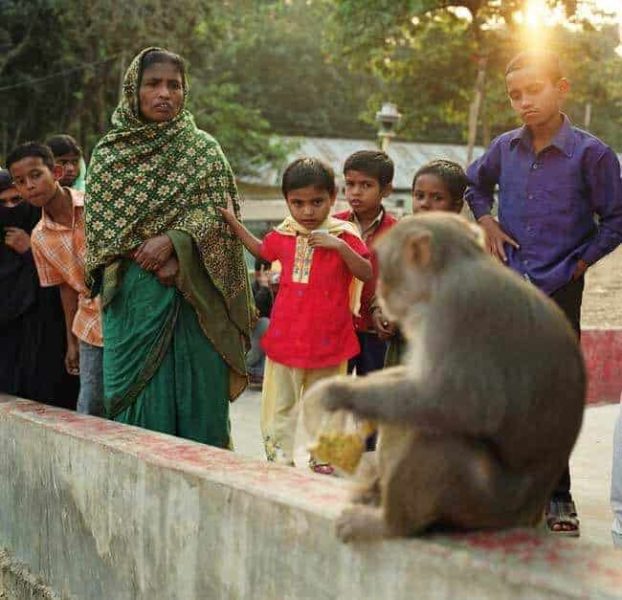Throughout Asia, humans and monkeys live side-by-side in many urban areas. An international research team from the University of Washington, Fred Hutchinson Cancer Research Center and Jahangirnagar University has been examining transmission of a virus from monkeys to humans in Bangladesh, one of the world’s most densely populated countries.
The scientists have found that some people in these urban areas are concurrently infected with multiple strains of simian foamy virus, including recombinant strains — those from more than one source — originally detected in the monkeys.
“These Asian rhesus macaques are Darwinian superstars,” said Lisa Jones-Engel, a primatologist with the National Primate Research Center at the UW and the project leader. “They are very responsive to change and, unlike many other species of primates, they are going to continue to thrive in human-altered habitats.”
Simian foamy viruses, which are ubiquitous in nonhuman primates, are retroviruses that exhibit high levels of mutation and recombination – a potentially explosive combination.
In a paper published Sept. 4 in the journal Emerging Microbes & Infections, the scientists characterize the simian retroviral strains that are being transmitted between species and provide a glimpse into the behaviors of humans and monkeys contributing to the infections.
By analyzing what is happening at the human-primate interface, the researchers hope to protect humans from another deadly outbreak similar to HIV. They focus on Asia because that continent has witnessed the emergence of several infectious diseases in the past decade. Asia also has a volatile combination of a population that is increasingly mobile and with a compromised immune response living in proximity with animals.
In the study, researchers collected biological samples from hundreds of people and macaques in five urban sites, as well as from a group of nomadic people who travel throughout Bangladesh with their performing monkeys.
The research team found that transmission of simian foamy virus between species occurred most commonly through bites. Simian foamy virus replicates in oral tissues and is secreted in the saliva of infected primates. In their study, more than half of the subjects reported having been bitten at least once by a rhesus macaque, but the percentage of subjects reporting having being bitten at each site varied significantly by subjects’ sex and religion. Researchers also found that primates, both human and nonhuman, can be infected with more than one strain of simian foamy virus, which is significant because co-infection can lead to viral recombination.
Among those infected with more than one strain of simian foamy virus – humans or macaques – recombination between the strains could occur.
Maxine Linial, a retrovirologist at the Fred Hutchinson Cancer Research Center, said successful viruses are readily transmitted and viruses evolve to be successful. She said viruses sometimes have effects on hosts to aid in transmission and these effects can have potential disease-causing consequences.
Simian foamy virus is not currently known to cause disease, but that was also the case for simian immunodeficiency virus before recombination and mutation allowed infection of and transmission between new hosts, Linial said.
“The possibility that a pathogenic SFV strain could arise makes it essential to monitor natural infections. If a viral strain with pathogenic potential arises, we will know about it early rather than too late, which was the situation with the emergence of HIV,” she said.
By using mutations in the viruses that differentiated them from one another, the researchers were able to group the viruses into strains. They found that these strains showed a strong geographic signal, where monkeys from each given area primarily had strains characteristic of that site. However, deforestation and human transport of monkeys concentrated the strains and then moved them.
The data show a population in transition, said Frederick Matsen, a computational biologist at Fred Hutchinson.
“If we were to sample 25 years earlier or 25 years later we would have seen a completely different story,” he said.
Since more humans have been shown to have been infected with simian foamy viruses through primate contact more than with any other simian-borne virus, the researchers reason that pinpointing the factors that influence transmission and infection are important to a general understanding of how viruses can jump the species barrier.
“If we want to understand how, where and why these primate viruses are being transmitted, we need to be looking at (simian foamy virus) in Asia where millions of people and tens of thousands of macaques are interacting every day and where we estimate that thousands of people could be infected with strains of SFV,” said UW researcher Jones-Engel.
Jones-Engel said if researchers had been on the ground 50 years ago, they may have seen how simian immunodeficiency viruses crossed the species barrier resulting in HIV.
“We have been playing catch up with the SIV-HIV question for years,” she said. “We still don’t know why only some viral strains are capable of establishing persistent infections in humans.”
Jones-Engel said long-term surveillance is needed in the areas where humans and primates come into contact, since it’s unlikely that SIV-HIV will be the last primate virus to emerge into the human population.
Regardless of whether simian foamy virus becomes a significant pathogen, researchers called for continued monitoring of the virus at the human and nonhuman primate interface.


